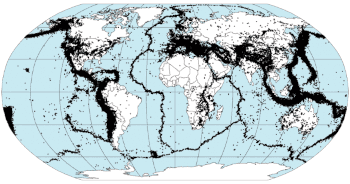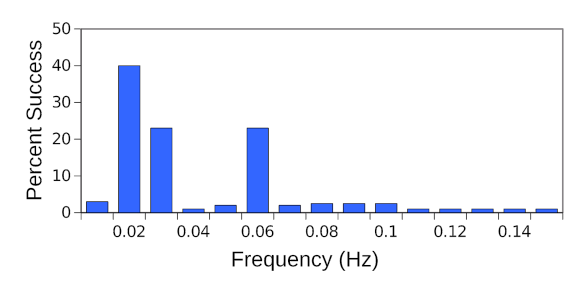Earthquake Light
November 20, 2023
There's a
Latin adage,
praemonitus praemunitus, "
forewarned is forearmed." As the many
deaths resulting from the recent
2023 Marrakesh–Safi earthquake and many other
earthquakes illustrate, a means of
earthquake prediction would be a worthy
scientific goal.
History is
replete with reports of
earthquake precursors, such as changing
water levels in
wells and unusual
animal behavior. There's evidence that
common toads may have
sensed the 6.3
magnitude L'Aquila, Italy, earthquake of April 6, 2009, three
days in advance.[1]
Contrarily, it was found that
ants did not change behavior prior to a much larger, 7.4 magnitude, earthquake.[1]

Active earthquake zones as defined by 358,214 earthquake epicenters, 1963-1998.
(Wikimedia Commons image. Click for larger image.)
At first glance, earthquake prediction doesn't appear to be that difficult a problem. We can measure water level very
accurately. The observed animal behavior might be caused by
seismic tremors, and we've got great instruments to measure seismic tremors with more sensitivity than a toad. Unfortunately, these approaches have not led to effective earthquake prediction.
Scientists have investigated other potential indicators, such as the
concentration of
radon in well water, changes in
electrical noise caused by the
piezoelectric effect in
rock under
stress, and
fractoluminescence. In fractoluminescence, the
electric fields caused by separation of the
crystal planes of
minerals will generate
light.
Considerable effort has been applied to measuring changes in local electric and
magnetic fields as earthquake predictors. Observations by the
Demeter (Detection of Electro-Magnetic Emissions Transmitted from Earthquake Regions) microsatellite, launched in mid-2004 and operational until the end of 2010, have shown a strong
correlation of
low frequency electromagnetic activity and seismic activity. The instruments aboard Demeter could detect electric field from
DC up to 3.5
MHz, and magnetic fields from a few
Hz up to 18
kHz.
Ultra-Low Frequency (ULF)
electromagnetic waves were detected by Demeter as it passed over
Haiti before and after the magnitude-7.0
earthquake that struck there on January 12, 2010.[2] A significant increase in ULF
energy was observed in the 30 day interval before the strong earthquake, and changes in energy were also observed 25 days after, coincident with strong
aftershock activity.[2]
Observation of ultra-low frequency signals appears to be a promising area for earthquake prediction. This
research area began when Antony Fraser-Smith, an
electrical engineer at
Stanford University, detected
high intensity ULF radio signals in the days leading up to the
Loma Prieta earthquake in 1989.[3] His
instrument was located seven
kilometers from the earthquake's epicenter.[3] As sometimes happens in science, this was an
accidental discovery by Fraser-Smith and a
graduate student.
Fraser-Smith and his student were working on a
US Navy program studying how
natural noise affects
satellite communication, especially the ultra-low frequency radio waves produced when the
solar wind interacts with
Earth's magnetosphere. Twelve days before the Loma Prieta earthquake, they recorded a large signal; and then, three hours before the earthquake, the signal went off scale. It was 20-30 times larger than the typical signal level.[3]

Preferred ultra-low frequencies for earthquake prediction. (Created using Gnumeric from data in fig. 4 of ref. 4.[4] Click for larger image.)
One potential
earthquake precursor is the occurrence of
earthquake lights, a
skyglow sometimes coincident with an earthquake, but often reported to occur prior to seismic activity. These lights are seen near the epicenter of high magnitude earthquakes (>5 on the
Richter scale), and have been seen as blue lights during earthquakes, and yellow,
ball-sized lights before an earthquake. They have been noted in
antiquity, also during the
Peru earthquake of August 15, 2007;[5] and, most recently, during the
2023 Marrakesh–Safi earthquake.[6]
Presumed earthquake lights coincident with the 2023 Marrakesh–Safi earthquake. Clip from a YouTube video by Sabine Hossenfelder.[7]
Fractoluminescence could explain lights happening during an earthquake, but there are two processes that might explain preseismic lights. One would be electric fields created
piezoelectrically by stresses in
quartz-containing rocks, such as
granite. Another would be
triboelectricity, when dissimilar
materials rub against each other.
Seconds before the
2009 L'Aquila, Italy earthquake struck, 10-
centimeter high
flames of light were seen
flickering above a
street in the
city's center.[8] A bright purple-pink
globe of light moved through the sky along the
St. Lawrence River on November 12, 1988, eleven days before a powerful earthquake.[8] In 1906, lights were seen running along the ground two nights preceding the
Great San Francisco Earthquake.[8]
A 2014 study of 65
documented cases since
1600 A.D. found evidence that earthquake lights are more common at
continental rifts, an example being the
Gulf of California.[8] The 65 earthquakes ranged from magnitude 3.6 to 9.2, and the earthquake lights most commonly appeared as stationary or moving globular luminous masses, as atmospheric illuminations or as flame-like luminosities emerging from the ground.[8] It's theorized that stress caused
charge carriers to flow along stress
gradients to the surface, and then
ionize air molecules to generate the earthquake lights.[8]
References:
- Matt Walker, "Toads can 'predict earthquakes' and seismic activity," BBC News, March 31, 2010.
- M. Athanasiou, G. Anagnostopoulos, A. Iliopoulos, G. Pavlos and K. David, "Enhanced ULF radiation observed by DEMETER two months around the strong 2010 Haiti earthquake," arXiv, December 7, 2010.
- Anthony C. Fraser-Smith, Arman Bernardi, Robert A. Helliwell, Paul R. McGill, and O.G. Villard, Jr., "Analysis of Low-Frequency-Electromagnetic-Field Measurements Near the Epicenter," in The Loma Prieta, California, Earthquake of October 17, 1989 - Preseismic Observations, Malcolm J.S. Johnston, Editor, U.S. Geological Survey Professional Paper 1550-C (PDF file). I wrote about Robert A. Helliwell in an earlier article (Very Low Frequencies, May 27, 2019.
- KA Yusof, M Abdullah, NSA Hamid and S Ahadi, "On effective ULF frequency ranges for geomagnetic earthquake precursor," Journal of Physics: Conference Series, Vol. 1152, International Conference on Space Weather and Satellite Application (ICeSSAT 2018, 7-8 August 2018), DOI 10.1088/1742-6596/1152/1/012033. This is an open access paper with a PDF file here.
- J. A. Heraud and J. A. Lira, "Co-seismic luminescence in Lima, 150 km from the epicenter of the Pisco, Peru earthquake of 15 August 2007," Nat. Hazards Earth Syst. Sci., vol. 11, no. 4 (April 5, 2011), pp. 1025-1036, https://doi.org/10.5194/nhess-11-1025-2011.
- Vishwam Sankaran, "Strange ‘earthquake lights’ spotted above Morocco moments before devastating tremors remain a mystery, Independent (UK), September 12, 2023 .
- Possible Signs of Life on Another Planet, YouTube video by Sabine Hossenfelder, September 18, 2023.
- Earthquake lights linked to rift environments, subvertical faults, Seismological Society of America Press Release, January 2, 2014.
- Lights Flashed in the Sky During Mexico's Latest Earthquake (a magnitude 7.0 earthquake on the night of Sept. 7, 2021. Why?, YouTube video by WGBH Educational Foundation, September 27, 2021.
Linked Keywords: Latin; adage; forewarned is forearmed; death; 2023 Marrakesh–Safi earthquake; earthquake; earthquake prediction; science; scientific; history; replete; earthquake precursor; water; water well; ethology; animal behavior; common toad; sense; sensed; moment magnitude scale; L'Aquila, Italy, earthquake; day; contrarily; ant; seismic zone; earthquake zone; epicenter; Wikimedia Commons; accuracy and precision; accurately; episodic tremor and slip; seismic tremor; scientist; concentration; radon; electrical noise; piezoelectricity; piezoelectric effect; rock (geology); stress (mechanics); fractoluminescence; electric field; crystal plane; mineral; light; magnetic field; Demeter (Detection of Electro-Magnetic Emissions Transmitted from Earthquake Regions); microsatellite; correlation; frequency; electromagnetic field; direct current; DC; hertz; megahertz; kilohertz; Ultra-Low Frequency; electromagnetic radiation; electromagnetic wave; Haiti; 2010 Haiti earthquake; energy; aftershock; research; electrical engineering; electrical engineer; Stanford University; intensity (physics); high intensity; 1989 Loma Prieta earthquake; scientific instrument; kilometer; serendipity; accidental discovery; postgraduate education; graduate student; United States Navy; atmospheric noise; natural noise; communications satellite; satellite communication; solar wind; Earth's magnetosphere; preferred ULF frequencies for earthquake prediction; ultra-low frequencies; Gnumeric; earthquake precursor; earthquake lights; skyglow; Richter scale; ball-sized; antiquity; 2007 Peru earthquake; Sabine Hossenfelder; quartz; granite; triboelectric effect; triboelectricity; material; rubbing; rub; second; 2009 L'Aquila, Italy earthquake; centimeter; flame; flicker (light); flickering; street; city; center (geometry); globe; St. Lawrence River; 1906 San Francisco earthquake; Great San Francisco Earthquake; document; documented; 1600 A.D.; continental rift; Gulf of California; charge carrier; gradient; ionization; ionize; atmosphere of Earth; air; molecule.